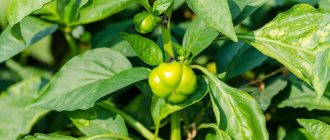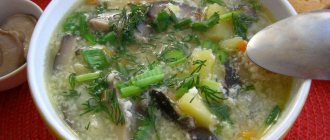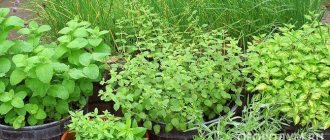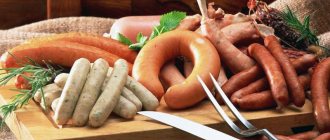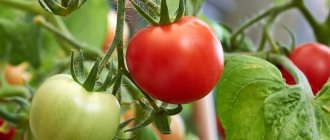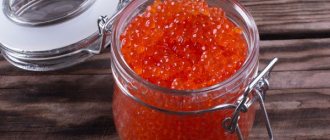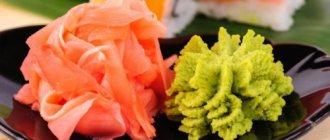Correct fit
To get a large harvest of ripened paprika, lay down the conditions for this at the very initial stages of crop development. Its further development and the timing of fruit ripening depend on the planting of the plant.
- Temperature. You can use the rule, the sooner you plant, the sooner you will get the harvest, with extreme caution. This will work in regions with warm climates. In other cases, the crop can only be planted in well-warmed soil.
- Plant the plant in a permanent place during a period when a stable, comfortable temperature has established. The thermometer readings should not fall below 180C during the day and 140C at night.
- Lighting. Paprika bushes love light. Lay out the area for beds for this crop in well-lit areas. When planting plants of different varieties, place them correctly. For tall crops, allocate a plot in the center of the bed; low-growing crops will feel great at the edges of the bed.
- Thickness. Follow the planting pattern for sweet peppers. During the growing season, the plant becomes powerful and spreading. Neighboring bushes will interfere with each other. Lack of light and nutrients will negatively affect the timing of fruit ripening.
- Priming. The culture loves fertile and light soil. Before planting, be sure to fertilize the soil in the beds with organic fertilizers. Apply dolomite flour to reduce soil acidity. To make the soil lighter, periodically loosen the beds.
- Fertilizers. Don't neglect feeding. For each period of crop development, certain nutrients are needed. You should not fertilize the plant with nitrogen during flowering or fruiting. A properly organized diet helps reduce the ripening time of fruits.
- Watering. Water the peppers rarely but generously. Creating high humidity for the crop will result in the development of fungal and bacterial diseases.
When to remove peppers from the garden for storage
You can harvest pepper at any stage of fruit growth - it all depends on your preferences. However, for storage in autumn and winter it is worth collecting peppers that have reached technical maturity.
Worth knowing! Technical maturity is an unripe fruit that has not yet turned red, but has grown to almost the required size and has become elastic and dense.
These sweet peppers should be collected 60-70 days after planting. Fruits at this stage can be put aside for ripening, but it is best to send it for long-term storage, because it is stored for 4-6 weeks longer than mature peppers. By the way, experienced gardeners recommend harvesting just at the moment of technical maturity. In this case, new fruits grow on the bushes much faster, and the yield increases.
Left: technically mature peppers. Right and center: biological maturity
Fruits at the stage of biological maturity are suitable for consumption and preservation. It occurs 20-25 days after technical maturity. At this time, the fruit acquires its color - yellow, orange or even purple. Ripe peppers contain the largest amount of substances valuable to the body: vitamin C, P vitamins, macro- and microelements, carotenoids. This is also the right time to collect seeds with maximum germination.
Topping
For normal development of the culture, two or three shoots are enough. Pinching the bushes will force the plant to save its energy and speed up the ripening of the peppers. Experienced gardeners do the following:
- on a still small bush, the crown bud is removed;
- during the period of active flowering, barren flowers are picked off;
- throughout the entire growth period, they get rid of excess shoots;
- at the end of summer, absolutely all the flowers are picked;
- During the period of approaching cold weather, small peppercorns are collected that will not reach maturity.
These simple manipulations allow the culture to direct all its resources to the ripening of the set fruits.
How long does it take for a pepper to ripen?
The growth and ripening of bell and bitter peppers takes place in several stages, each of which has its own characteristics.
- It takes 13-15 days from seed germination to the formation of strong and healthy seedlings.
- After the appearance of 2 cotyledon leaves, 17-20 days pass before the formation of the first true leaf.
- It takes the plant 6-7 days to form each further true leaf.
- The budding stage depends on the specific pepper variety and can occur 50-95 days after germination.
- After the formation of the first bud, 14-24 days pass until the stage of intensive flowering.
- It takes at least 5-6 days for each bud to bloom.
- From the date of formation of the ovaries to the stage of technical maturity, 25-30 days pass; after another 20-30 days, full biological ripeness of the pepper occurs.
The ripening time of bell and bitter peppers depends on their varietal. For early-ripening species, technical maturity occurs 75-80 days after the appearance of the first shoots, for late-ripening species - after 150-165 days.
Recommendations
You need to water with warm water
Gardeners have learned in practice that it is possible to speed up the ripening of paprika fruits by resorting to little tricks. These include:
- creation of additional shelters;
- maintaining optimal temperature conditions;
- watering the crop with hot water;
- foliar feeding of plants;
- removal of deciduous mass.
Covering
After planting the seedlings in a permanent place, maintain a constant favorable temperature regime. For peppers, the comfort zone ranges from 200C to 250C during the day and from 150C to 180C at night.
To ensure this, build a shelter for the plants. Use non-woven material, agrofibre. Cover crop beds as needed.
Continue to use such shelters during the first autumn colds. This way you can harvest before frost sets in.
Ventilation
At the end of summer and beginning of autumn, condensation forms in greenhouses due to differences in day and night temperatures. This leads to the proliferation of pathogenic fungi and pathogenic bacteria. The plant stops developing.
To get rid of this problem, ventilate the greenhouse. Leave the room open during the day and close it at night.
Tips and tricks
To grow healthy, strong bushes and obtain a rich harvest of tasty, juicy and crispy fruits, you need to take into account some of the subtleties of the agricultural technology of bell and bitter peppers.
- When growing different types of peppers, you need to remember the rules of crop rotation. It can be planted in beds after nightshade crops no earlier than after 3-4 years. The best “predecessors” are considered to be white cabbage, cucumbers, beans and peas.
- If pepper is grown in one area for several years, the fertile qualities of the soil can be improved with the help of green manure. After harvesting, sow the garden with green manure, and at the end of autumn, mow down the lush above-ground part and embed it in the ground while digging to the depth of a spade bayonet.
- To feed peppers, you cannot use fresh chicken manure, cow or horse manure. They must be diluted with clean water (litter 1:20, manure 1:10), otherwise the organic compounds will burn the delicate plant.
Every summer resident can speed up the ripening of bell and bitter peppers using simple, affordable and effective agricultural techniques. Proper watering, formation and feeding of the bush, regular loosening and mulching of the soil in the garden or greenhouse will help speed up the ripening of tasty, large and juicy fruits.
Can peppers ripen at home after harvesting?
Long-term storage of bell peppers at home can only be achieved if you adhere to a few simple but very important rules.
There are two stages of vegetable maturity:
- technical - in which the pepper has a pale green or green color;
- biological - in this case, the peppers become red, orange, that is, they completely acquire the necessary colors.
Vegetables can be stored at any stage, but in the first case, special conditions should be organized under which they could ripen.
Fruits collected in the technical ripeness phase can be stored for more than two months and gradually ripen if:
- immediately after harvesting, keep them in a dry room for one month at a constant temperature of +9. +11°С. The optimal place for storage is a balcony, basement, cellar, pantry; the best containers are wooden or plastic boxes;
- During harvesting, dig up the pods along with the stalks and hang them in a cool place. If the room is cool but bright, then it is recommended to cover the fruits with natural, “breathable” fabric.
To speed up the ripening of fruits after harvesting, you should place the required number of peppers in the light. To summarize, it can be noted that for the full ripening of green fruits at home, the following conditions should be adhered to:
- absence of direct sunlight, under the influence of which the fruits simply “cake”;
- presence of constant temperature indicators +9. +11°С, no higher and no lower;
- maintaining a humidity level of 90–95% (ideally).
How to tell if a pepper is ripe
Determining that bell or hot peppers are fully ripe is not difficult even for a novice vegetable grower.
Signs of fruit ripeness:
- color - in ripe fruits it becomes bright red, yellow-orange, purple or black-brown;
- shape and size - they must exactly correspond to the characteristics of a given variety or hybrid;
- texture – a ripe vegetable has a crunchy, elastic and juicy pulp structure.
Ripe peppers have a light vegetable aroma and a pleasant sweetish taste. Some varieties allow a slight sourness in taste, making it more balanced.
Features and timing of harvest
It is recommended to harvest the Bulgarian vegetable at the stage of technical ripeness, when the fruits are fully formed in size, but do not have the proper color. As a rule, the technical maturity phase begins 2.5–3 months after the formation of the first shoots.
The timing of technical ripening of fruits varies depending on the variety of pepper and in most cases is indicated on the package with seeds. Fruits collected during this period can be stored for two or more months, gradually ripening without losing their nutritional value and taste.
It will take several weeks for bell peppers to move from the technical phase of ripening to the biological phase. The duration of this process will be determined by several important factors: air temperature and humidity level.
The onset of the bioripening stage will be signaled by a change in the color of the pod - from green to orange, red or yellow, depending on the variety of crop. Also, the full ripeness of the fruit is indicated by a characteristic crunch that can be heard when pressing on the skin.
Unripe peppercorns do not have such a sound. Typically, harvesting is carried out selectively, several times a week, as the vegetable is ready. Full fruit harvesting is carried out when there is a risk of night frosts.
As for the calendar dates for harvesting, they will depend on the climatic conditions of the region, as well as the place of cultivation - open ground or greenhouse. The first harvests begin in mid-to-late August and continue until the onset of cold days.
Why don't peppers turn red in a greenhouse? Pepper does not turn red in the garden: what to do?
Many people who are far from gardening believe that bell peppers must be red. This is far from true, but even experienced gardeners most often plant red-fruited varieties. It happens that the fruits hang on the bushes and are not going to turn red. There are not very many reasons for this.
Why don't bell peppers turn red in the garden?
In general, the reasons that peppers do not turn red in a greenhouse or open ground lie in the nature of the variety or in the state of the weather (sometimes the gardener’s mistakes are also to blame). Thus, not all varieties of pepper sold in stores (especially in winter!) can ripen in regions that are not the hottest. And it often happens that an inexperienced gardener takes seeds from purchased fruits for sowing.
Even zoned varieties can have yellow, purple, white and even green coloring of completely ripe fruits, although most often peppers at the technical stage of ripeness are green.
Pepper Star of the East white will never turn red
But in full (biological) ripeness, peppers are only slightly tastier and healthier than in technical ripeness, when the fruit is already fully formed and its growth has stopped. For most varieties to reach full ripeness, it will take another month, and, in general, there is no need to wait this period: fruits left on the bushes until they are fully ripe only interfere with the growth of others. Therefore, most gardeners collect peppers precisely in a state of technical ripeness: they are well stored and gradually ripen at home.
Most varieties of peppers at technical ripeness are light green in color.
If the gardener thinks that the pepper should already be red by date, he needs to carefully check the varietal characteristics. Perhaps the ripening dates indicated on the seed packaging refer specifically to the period when the peppers are ready to eat, but have not yet acquired their final color. If there is no error, it is worth looking for the reason for the delayed maturation. It can be:
- lack of heat (at daytime temperatures below 20–22 °C and night temperatures below 15 °C, peppers develop very slowly, and at 12 °C their growth stops altogether);
- slow development due to damage to roots when planting seedlings;
- sudden weather fluctuations (excessive heat, heavy rains or, conversely, drought);
- lack of nutrients in the soil or, conversely, a significant excess of nitrogen fertilizers;
- diseases, pests.
Any of these factors can delay the redness of the fruit by a week or two, or even a month.
What can be done to solve the problem
If the problem is the weather or improper care, you should try to eliminate the cause. When it gets cold, cover the plants with non-woven materials, if there is a lack of nutrition, feed them, water them with warm water and without fanaticism. When large but green fruits are already hanging on the bushes, the peppers do not need nitrogen at all, but they do require fertilizing with wood ash.
If the fruits have already reached the desired size, it is better to remove them, and if you want to get red ones, ripen them at home. They need to be laid out in a warm place (not in the full sun) and turned over periodically. The process will go much faster if you put a couple of red specimens nearby, or maybe a ripe apple. Peppers are often placed on foil, which reflects the heat of the sun falling on it and warms the fruit.
If you wish, you can speed up the reddening of peppers even on bushes, although there is not much point in this. For example, you can put banana peels directly under them, but this way you can also attract pests. A more reliable method, but a little barbaric, is to slow down the growth of the entire bush. At a height of several centimeters, a through hole is made in the stem (a split 2–3 cm long). An ordinary chip is placed in it, which stops the development of the bush and forces it to redistribute its forces to the ripening of fruits. The gardener receives red peppers, but after a week he loses the whole plant.
The reasons why peppers do not turn red on the bushes are mainly due to the characteristics of the variety or the vagaries of the weather. But bell pepper is a crop whose fruits are better not to be allowed to fully ripen in the garden: they are edible even in an unripe state, but can ripen during storage.
Optimal storage conditions
Bell peppers do not have good shelf life, so for their storage it is necessary to organize optimal conditions:
- The most comfortable temperatures for storing fruits are considered to be no more than +10°C, while the relative humidity should range from 80–95%;
- fruits for storage are placed in containers in 2-3 layers, if possible, each of them is wrapped in paper;
- pepper is stored in a room separate from all other vegetables, as it easily absorbs foreign odors;
- In refrigerator conditions, vegetables are stored at a temperature of no more than +9. +10°C and humidity not lower than 80%;
- Fully ripe peppers are stored in a room with a temperature of 0 to +2°C and a humidity level of about 90%.
Periodically, all fruits in boxes are inspected for damage or rot. All bad specimens are discarded.
How to store peppers until they turn red. How to ripen pepper
Various methods are used to ripen bell peppers. How to store peppers so they turn red faster? To do this, place several red or yellow ripe vegetables between the collected fruits and place them in a warm, dark place for 4-5 days.
Temperature and storage conditions
For long-term maintenance, peppers are picked at the stage of technical ripeness. They are placed in 3 layers in small containers, which are left in a room with a temperature of +10...+12°C and an air humidity of 85–90%. Under such conditions, the fruits fully ripen in 1 month. After this, the temperature is lowered to 0°C to prevent the development of diseases. In room conditions, ripening is much faster.
One way to store fruits in a basement or cellar is to hang the bushes directly with the roots. Plants are planted at home in flower pots or wooden boxes for further ripening of vegetables.
Lifehacks
To speed up fruit ripening, various methods are used:
- during the period of vegetative growth of bushes, weak shoots are pinched and cut off;
- during fruiting, foliar feeding is applied: solutions of potassium and phosphate fertilizers are used;
- at the end of August, the remaining flowers are removed;
- in early to mid-autumn, small peppers that have not yet had time to ripen are picked. This will give the bushes the strength to grow large fruits before the onset of cold weather;
- to speed up the ripening of vegetables, at the end of autumn the crop is watered with warm water (+45...+50°C) at the root, without touching the green mass;
- in autumn, during cold nights, the bushes are covered with agrofibre or plastic film;
- tear off most of the leaf mass from plants for better ripening of fruits;
- To make vegetables ripen faster, at the end of the season they loosen the soil around the bushes as deeply as possible.
Degrees of maturity
Fruits go through two stages of maturity: technical and biological.
At technical ripeness, vegetables reach optimal size, taste and beneficial qualities, but have not yet acquired the color characteristic of the variety. After harvesting, such fruits are transported, stored, and sold.
Vegetables at the stage of technical maturity are green or pale yellow, sometimes almost white. They are selectively removed every 6–8 days. Harvesting occurs at the end of autumn, before the onset of the first frost. With the advent of constant cold weather, the remaining harvest is completely harvested.
If you place the fruits in a warm, bright place, they will acquire the appropriate color in a short time.
Biological maturity is the physiological ripeness of peppers when they acquire their final color, becoming red, yellow, orange.
Reference! If bell peppers are picked at this stage, they will not keep for long.
It takes 3-4 weeks from technical to biological maturity of vegetables. During this period, the content of vitamins, sucrose and other valuable substances in the fruit increases.
The degree of biological ripeness of bell peppers is determined by gently pressing on the skin. If you hear a slight crunching sound, it means the vegetables are fully ripe.
Choosing a storage location
Vegetables at any stage of ripening (technical or biological) must be stored in a cool, dry place, away from direct sunlight and low humidity. Storage for storage can theoretically be organized in any room where the temperature varies within +2. +7°С.
At home, to preserve fruits, you can choose:
- Basement or cellar. The temperature in a cellar or basement in winter rarely rises above + 10°C, so these places are excellent for long-term storage of peppers. For better preservation, it is recommended to pack the fruits in boxes with dry sawdust or sand, or wrap each fruit in a thin layer of paper. Under such conditions, peppers will not lose their aesthetic appearance and taste for 4-5 months.
- Fridge. An excellent place to store peppers, because, thanks to the stability of the microclimate, it helps prevent rotting and spoilage of vegetables. To preserve the fruits in the refrigerator, they should be wrapped in paper, and you can also grease each pod with vegetable oil. This storage location has two significant drawbacks: firstly, the shelf life is only 2.5–3 months, and secondly, a limited amount of vegetables can be stored.
- Balcony. On the balcony, peppers are stored in containers, wooden, plastic or cardboard boxes filled with sand or sawdust.
What to do to make peppers turn red
Accelerating ripening on the vine
Adding heat
When it comes to cold weather, there is only one solution - to insulate the plants in every possible way. Build additional shelter in the greenhouse, place cobblestones or bottles of water on the garden bed to accumulate heat, or turn on the heaters at night - everyone chooses according to their possibilities.
Feed with ash or potash fertilizer
Whoever feeds peppers in the morning is doing wisely! When quite large but still green fruits are already hanging on the bush, it’s time to fertilize with potassium. Here are some options:
- before watering, scatter ash over the garden bed at the rate of two tablespoons per bush;
- dissolve one teaspoon of potassium sulfate in 10 liters of water;
- dilute two teaspoons of superphosphate and potassium salt in 10 liters of water.
All feeding options for peppers and eggplants: from the seedling stage to fruiting! Choose the best option:
We remember that in cold weather, peppers need twenty percent more potassium than under favorable conditions.
Harvesting the first harvest
To obtain red peppers, experienced gardeners advise harvesting more often. This is especially true for the very first peppers. Pick them green, not too large, and then the next peppers will begin to turn red much faster. If the fruiting is very abundant, you can remove the “second wave” from the bush when the first signs of color change appear and bring it to ripeness at home. Then the next ones will turn red even faster.
Banana peel to the rescue
Banana skins placed in a garden bed under pepper bushes speed up the ripening of fruits. Firstly, they emit ethylene, which helps all vegetables and fruits ripen. Secondly, they provide the soil with additional potassium. True, the sweet banana smell can attract pests to peppers - slugs, for example. But if you grow peppers on the terrace in containers... place a banana peel under the bush and cover the entire bush along with the pot with covering material for a couple of days.
We remove everything unnecessary
If the dacha season is nearing the end, the temperatures are already low even in the greenhouse, it makes sense to leave only large fruits on the bush. And tear off all the flowers and ovaries. Then all the energy of the bush will be directed to ripening the remaining peppers.
We place a sliver in the stem as the final point
Finally, the most radical method of accelerated ripening is “killing” the bush. It is also used at the threshold of finishing garden work, when the main harvest has already been harvested. 3-4 centimeters from the ground, we make a through hole in the pepper stem - a split 2-3 centimeters long. Insert a wood chip into the hole. The growth and development of the bush stops completely, the remaining nutrients are used to ripen the fruit, after which the plant dies.
Don't have the time, desire or ability to pierce the stems or heat the greenhouse? No problem, green peppers ripen just fine at home with a little help.
Ripening peppers at home
If the peppers are taken from the bush when they are technically ripe, they reach the desired state well in the warmth.
It is enough to spread the fruits in a warm place, put one ripe pepper or apple there, and the peppers will begin to turn red. Another working method: ripening on foil. It is necessary to spread food foil on the windowsill (preferably not on the northern one) and place green peppers on it. Due to light reflection, the peppers will receive more sunlight and heat, and the ripening process will go faster.
When the harvest is large, place the peppers in paper bags (or boxes) along with the apples (or bananas). And seal the package tightly. The result will not be long in coming.
Green peppers are not a problem at all, as long as they are there. And now we know how to arrange them so that they quickly turn red, yellow or orange. And you too!
We wish you success and great harvests!
Useful tips
Storing fresh bell peppers at home is not an easy task, since the vegetable has a delicate, juicy and very fragile structure, quickly withers and reacts negatively to low temperatures.
In order to preserve the external and taste qualities of fruits for as long as possible, you should follow several recommendations:
- Before placing them in containers, all vegetables should be sorted and defective ones should be selected;
- do not tear off the tip with the stalk, because it is he who is responsible for the quality and duration of storage;
- Peppercorns should not be washed before storing. Washed fruits, even under ideal storage conditions, will not be able to remain for a long time;
- vegetables must be placed in boxes lined with paper, sawdust or sand, in several layers;
- It is allowed to wrap each vegetable in paper or cling film. However, with this storage method, peppers must be visually inspected for damage weekly.
Pepper maturity stages
The maturity of bell and bitter peppers can be of two types - biological and technical. In the first case, the pepper fruits fully correspond to the declared varietal characteristics - in color, size and taste.
Technical maturity is unripe fruits of greenish color. Pepper can be harvested at any stage of ripeness - biologically mature fruits are picked for fresh consumption and for preparing various dishes. At the stage of technical maturity, peppers are removed from the bush for canning and long-term storage.
Technical
Technical maturity is the stage of vegetative development at which the fruits already have the required size, but differ in color. If biologically ripe pepper can have a red, yellow, orange, purple or brownish color, then during technical maturity it is only green, slightly yellowish or whitish.
Technically mature fruits are removed from the bush for long-term storage (up to 8-10 weeks), transportation or sale.
Biological
Biologically mature fruits are fully ripe peppers with a characteristic red, orange, purple or black-brownish color with seeds. The fruits ripen gradually and can be picked from the bush every 5-7 days.
Such a harvest cannot be stored for longer than 10-13 days, so it is immediately consumed as food and used for preparing various dishes and winter preparations.
When growing hot pepper, you need to take into account that it is removed from the bush only after reaching full biological ripeness. Unripe fruits do not have a characteristic pungency; their taste differs from those stated in the description of the variety or hybrid.
How to speed up the ripening of tomatoes
1. Water the bushes with a pink solution of potassium permanganate for 2-3 days.
2. Spray the plants on the leaves with iodine solution (30-35 drops per 10 liters of warm water). Once a week, water the tomatoes at the root with iodine (20 drops per 10 liters of water), mixed with 1 liter of fermented milk whey. Consumption per bush is about 2 liters.
3. Using a pointed wooden stick, make 2-3 punctures (to a depth of 2-3 mm) near the stalk. The fruits will ripen faster, but will not be stored for a long time.
How to speed up the ripening of peppers and eggplants
17. To allow the roots to “breathe”, regularly loosen the soil to a depth of 5-7 cm.
18. Remove all fruits that have reached the desired size and place them in a warm place to ripen.
19. On a tall stem, using a sharp knife or blade, make a through longitudinal cut 7-10 cm long, 15 cm above the soil surface. Insert a wooden chip 4-5 mm thick into it. Then the plant will direct nutrients not to the leaves, but to the fruits.
20. Treat the leaves of the plants with infusion of ash (2 cups per 10 liters of water).
What to do with green peppers. The pepper is not ripe
I have collected a decent harvest of sweet peppers. But the trouble is - he hasn’t matured! It’s already frosty, but it remains dark green in color.
And in addition, it was apparently pollinated with hot pepper, and now it’s also bitter. And my hot pepper grew from these seeds
Tell me, what should I make from this pepper? What preparations should I use it in? I’ve already frozen it for stuffing, and stuffed it several times. And there’s still plenty of it.
| and get the opportunity to rate materials, communicate in comments and much more!')">and get the opportunity to rate materials, communicate in comments and much more!')"> |
Copy the code and paste it into the window for creating a post on LiveInternet, having first enabled the “Source” mode there.
